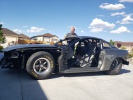What are people changing in the cam tables? Are there gains in economy and/or power to be had?
I've gone through my first generation of a "boost bump" tune, and I'm quite happy with the results. I only modified air load above 2500 rpm because of the article I read here about SIDI engine modes and how we cannot add more fuel below that value. So i have a smooth ramp up from stock boost to about 20PSI at 3000rpm and drops off to about 18-19 at redline. I also slightly richened up the 90 and 100% load tables. It's very smooth, and im really only getting tip-in knock retard that can be seen on a stock tune. Also, there's a little more room to grow if need be. My max MAF output was 32 lbs/min, so it's at least competitive with other tunes out there
Has anyone been able to completely eliminate knock retard on this system, or is it just a product of how the system works? I've read here that if you're not getting a little knock retard, then you not making as much power as you should be. Seems like faulty logic to me, but i'll ask anyway. I occasionaly get 1 degree KR or so under WOT, but I've seen as much as 3 degrees on throttle transitions, which is kinda scary.
Thanks for reading!




 Reply With Quote
Reply With Quote

